 Suzuki Grand Vitara: Seat Belts and Child Restraint Systems
Suzuki Grand Vitara: Seat Belts and Child Restraint Systems
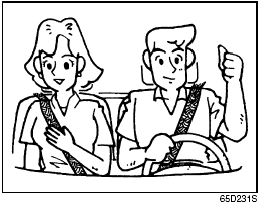
 WARNING: An air bag supplements,
or adds to, the frontal crash protection offered by seat belts. The driver and all
passengers must be properly restrained by wearing seat belts at all times, whether
or not an air bag is mounted at their seating position, to minimize the risk of
severe injury or death in the event of a crash.
WARNING: An air bag supplements,
or adds to, the frontal crash protection offered by seat belts. The driver and all
passengers must be properly restrained by wearing seat belts at all times, whether
or not an air bag is mounted at their seating position, to minimize the risk of
severe injury or death in the event of a crash.
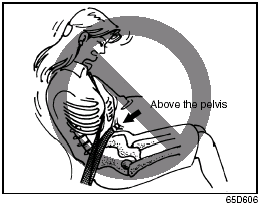
 WARNING:
WARNING:
• Never allow persons to ride in the cargo area of a vehicle. In the event of an
accident, there is a much greater risk of injury for persons who are not riding
in a seat with their seat belt securely fastened.
• Seat belts should always be adjusted as follows: – the lap portion of the belt
should be worn low across the pelvis, not across the waist. – the shoulder straps
should be worn on the outside shoulder only, and never under the arm. – the shoulder
straps should be away from your face and neck, but not falling off your shoulder.
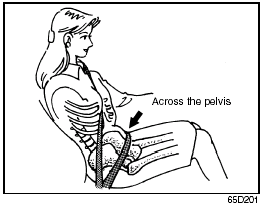
• Seat belts should never be worn with the straps twisted and should be adjusted
as tightly as is comfortable to provide the protection for which they have been
designed. A slack belt will provide less protection than one which is snug.
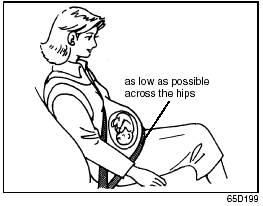
• Pregnant women should use seat belts, although specific recommendations about
driving should be made by the woman’s medical advisor. Remember that the lap portion
of the belt should be worn as low as possible across the hips, as shown in the diagram.
• Make sure that each seat belt buckle is inserted into the proper buckle catch.
It is possible to cross the buckles in the rear seat.
• Do not wear your seat belt over hard or breakable objects in your pockets or on
your clothing. If an accident occurs, objects such as glasses, pens, etc. under
the seat belt can cause injury.
• Never use the same seat belt on more than one occupant and never attach a seat
belt over an infant or child being held on an occupant’s lap. Such seat belt use
could cause serious injury in the event of an accident.
• Periodically inspect seat belt assemblies for excessive wear and damage. Seat
belts should be replaced if webbing becomes frayed, contaminated, or damaged in
any way. It is essential to replace the entire seat belt assembly after it has been
worn in a severe impact, even if damage to the assembly is not obvious.
• Children age 12 and under should ride properly restrained in the rear seat, if
equipped.
• Infants and small children should never be transported unless they are properly
restrained. Restraint systems for infants and small children can be purchased commercially
and should be used. Make sure that the system you purchase meets Federal Motor Vehicle
Safety Standards. Read and follow all the directions provided by the manufacturer.
• Avoid contamination of seat belt webbing by polishes, oils, chemicals and particularly
battery acid. Cleaning may safely be carried out using mild soap and water.
• For children, if the shoulder belt irritates the neck or face, move the child
closer to the center of the vehicle.
• All seatbacks should always be in an upright position when driving, or seat belt
effectiveness may be reduced. Seat belts are designed to offer maximum protection
when seatbacks are in the upright position.
Lap-Shoulder Belt
Emergency Locking Retractor (ELR)
The lap-shoulder seat belt has an emergency locking retractor (ELR), which is designed to lock the seat belt only during a sudden stop or impact. It also may lock if you pull the belt across your body very quickly. If this happens, let the belt go back to unlock it, then pull the belt across your body more slowly.
Automatic Locking Retractor (ALR)
The front passenger’s seat belt and the rear seat belts have emergency locking retractors (ELRs) that can be temporarily converted to function as automatic locking retractors (ALRs). The ALR mode should be used if you need to secure a child restraint system in the seat. Refer to the “Child Restraint Systems” section for details.
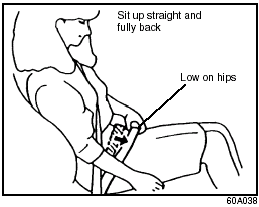
Safety reminder
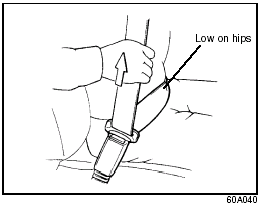
Safety reminder
To reduce the risk of sliding under the belt during a collision, position the lap portion of the belt across your lap as low on your hips as possible and adjust it to a snug fit by pulling the shoulder portion of the belt upward through the latch plate. The length of the diagonal shoulder strap adjusts itself to allow freedom of movement.
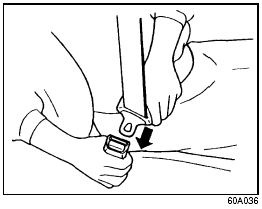
To fasten the seat belt, sit up straight and well back in the seat, pull the latch plate attached to the seat belt across your body and press it into the buckle until you hear a “click”.
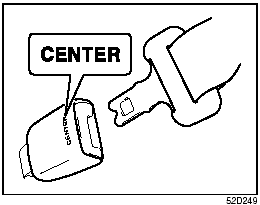
NOTE: The word “CENTER” is molded into the buckle for the rear seat center belt. The buckles are designed so a latch plate can not be inserted into the wrong buckle.
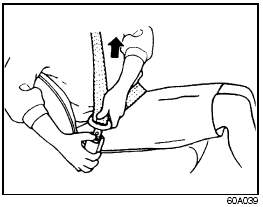
To unfasten the belt, push the red “PRESS” button on the buckle and allow the belt to retract.
Seat Belt Reminder
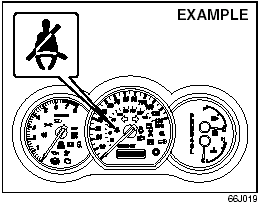
Driver’s seat
belt reminder light
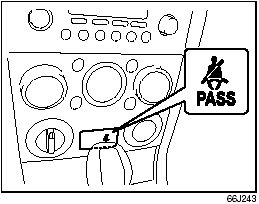 Front passenger’s
seat belt reminder light
Front passenger’s
seat belt reminder light
When the driver and front passenger don’t buckle their seat belts, the driver’s seat belt reminder light in the instrument cluster and the front passenger’s seat belt reminder light in the center of the instrument panel will come on and a buzzer will sound as a reminder to the driver and front passenger to buckle their seat belts.
 WARNING: It is absolutely essential
that the driver and passengers wear their seat belts at all times. Persons who are
not wearing seat belts have a much greater risk of injury if an accident occurs.
Make a regular habit of buckling your seat belt before putting the key in the ignition.
WARNING: It is absolutely essential
that the driver and passengers wear their seat belts at all times. Persons who are
not wearing seat belts have a much greater risk of injury if an accident occurs.
Make a regular habit of buckling your seat belt before putting the key in the ignition.
The seat belt reminder functions as shown in the figure below. There are some differences between the driver’s seat belt reminder and the front passenger’s seat belt reminder. For more details, refer to the explanation below.
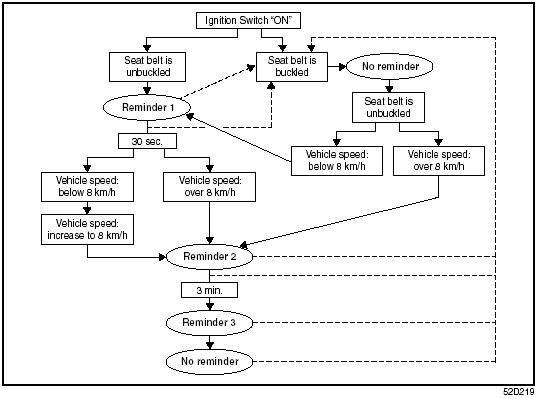
Flow chart
Reminder 1 – 3
For each reminder 1 – 3, the reminder light comes on for about 20 seconds, then blinks for about 55 seconds. When the reminder light first comes on, a buzzer sounds intermittently for about 6 seconds.
Driver’s seat belt reminder
If the driver’s seat belt remains unbuckled with the ignition key in the “ON” position, the driver’s seat belt reminder works as follows: 1) The driver’s seat belt reminder light will come on for about 20 seconds when the ignition key is turned to the “ON” position then will blink for about 55 seconds. When the light comes on, a buzzer will also sound intermittently for about 6 seconds (Reminder 1). 2) If the vehicle is driven (vehicle speed > 8 km/h), Reminder 2 will operate about 30 seconds after Reminder 1 has finished. If the vehicle is not driven (vehicle speed < 8 km/h), Reminder 2 will operate when driving starts (vehicle speed > 8 km/h). 3) Reminder 3 will operate about 3 minutes after Reminder 2 has finished. 4) Even if the driver’s seat belt remains unbuckled after Reminder 3, there will be no further reminders.
If the driver has buckled his or her seat belt and later unbuckles the seat belt, the reminder system will be activated from Reminder 1 or Reminder 2 according to the vehicle speed. (Refer to the flow chart.) The driver’s seat belt reminder will be automatically canceled when the driver’s seat belt is buckled or the ignition switch is turned off.
Front passenger’s seat belt reminder
The front passenger’s seat belt reminder will activate only when there is a passenger sitting in the front seat. In some situations, however, such as when you place heavy objects in the front seat, the seat belt reminder can be activated as if there were a passenger present. The front passenger’s seat belt reminder works in the same manner as the driver’s seat belt reminder, except that it is not activated until 10 seconds after the ignition switch is turned to the “ON” position.
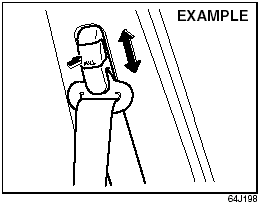 Shoulder anchor
height adjuster (if equipped)
Shoulder anchor
height adjuster (if equipped)
Adjust the shoulder anchor height so that the shoulder belt rides on the center of the outside shoulder. To adjust the shoulder anchor height, slide the anchor up simply or slide the anchor down while pulling the lock knob out. After adjustment, make sure that the anchor is securely locked.
 WARNING: Be sure that the shoulder
belt is positioned on the center of the outside shoulder. The belt should be away
from your face and neck, but not falling off your shoulder. Misadjustment of the
belt could reduce the effectiveness of the safety belt in a crash.
WARNING: Be sure that the shoulder
belt is positioned on the center of the outside shoulder. The belt should be away
from your face and neck, but not falling off your shoulder. Misadjustment of the
belt could reduce the effectiveness of the safety belt in a crash.
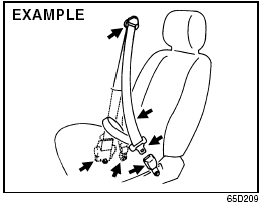
Seat Belt Inspection
Periodically inspect the seat belts to make sure they work properly and are not damaged. Check the webbing, buckles, latch plates, retractors, anchorages and guide loops. Replace any seat belts which do not work properly or are damaged.
 WARNING: Be sure to inspect all
seat belt assemblies after any collision. Any seat belt assembly which was in use
during a collision (other than a very minor one) should be replaced, even if damage
to the assembly is not obvious. Any seat belt assembly which was not in use during
a collision should be replaced if it does not function properly, it is damaged in
any way or the seat belt pretensioners were activated (that is, if the front air
bags were activated).
WARNING: Be sure to inspect all
seat belt assemblies after any collision. Any seat belt assembly which was in use
during a collision (other than a very minor one) should be replaced, even if damage
to the assembly is not obvious. Any seat belt assembly which was not in use during
a collision should be replaced if it does not function properly, it is damaged in
any way or the seat belt pretensioners were activated (that is, if the front air
bags were activated).
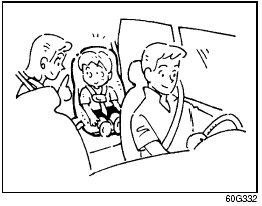 Child Restraint
Systems
Child Restraint
Systems
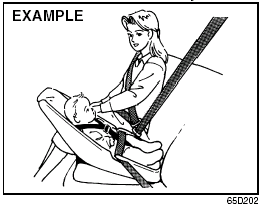
Infant restraint
- rear seat only
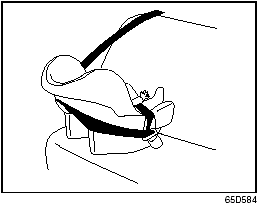
Infant restraint
- rear seat only
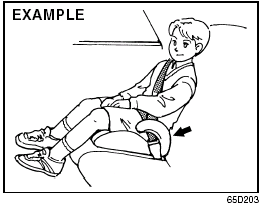
Booster seat
SUZUKI highly recommends that you use a child restraint system to restrain infants and small children. Many different types of child restraint systems are available; make sure that the restraint system you select meets Federal Motor Vehicle Safety Standards. All child restraint systems are designed to be secured in vehicle seats by either seat belts (lap belts or the lap portion of lapshoulder belts) or by special rigid lower anchor bars built into the seats. Whenever possible, SUZUKI recommends that child restraint systems be installed on the rear seat. According to accident statistics, children are safer when properly restrained in rear seating positions than in front seating positions. If you must use a front-facing child restraint in the front passenger’s seat, be sure to move the front passenger’s seat as far back as possible.
 WARNING: Children could be endangered
in a crash if their child restraints are not properly secured in the vehicle. When
installing a child restraint system, be sure to follow the instructions below. Be
sure to secure the child in the restraint system according to the manufacturer’s
instructions.
WARNING: Children could be endangered
in a crash if their child restraints are not properly secured in the vehicle. When
installing a child restraint system, be sure to follow the instructions below. Be
sure to secure the child in the restraint system according to the manufacturer’s
instructions.
 WARNING: In an accident or sudden
stop, the rear seat armrest (if equipped) could fall forward. If there is a child
in a rear-facing child restraint in the center seating position, the falling armrest
could injure the child. Make sure the armrest is back in the seat and locked when
not in use.
WARNING: In an accident or sudden
stop, the rear seat armrest (if equipped) could fall forward. If there is a child
in a rear-facing child restraint in the center seating position, the falling armrest
could injure the child. Make sure the armrest is back in the seat and locked when
not in use.
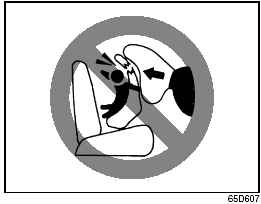
 WARNING: Do not install a rear-facing
child restraint in the front passenger’s seat. If the passenger’s air bag inflates,
a child in a rear-facing child restraint could be seriously injured. The back of
a rear-facing child restraint would be too close to the inflating air bag.
WARNING: Do not install a rear-facing
child restraint in the front passenger’s seat. If the passenger’s air bag inflates,
a child in a rear-facing child restraint could be seriously injured. The back of
a rear-facing child restraint would be too close to the inflating air bag.
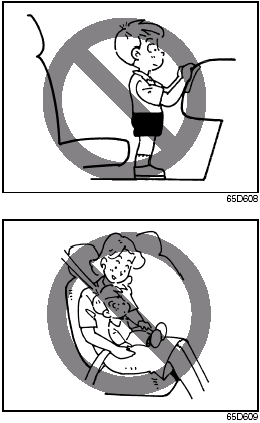
Installation with Lap-Shoulder Seat Belts (Child Restraint with No Top Strap)
NOTE: There are two types of lap-shoulder belts depending on the vehicle’s specification, A-ELR (Automatic-Emergency Locking Retractor) type and ELR (Emergency Locking Retractor) type. The A-ELR type belts have emergency locking retractors (ELRs) that can be temporarily converted to function as automatic locking retractors (ALRs). The ELR type belts have ELRs that can not be converted to function as ALRs.
To identify the belt is the A-ELR type or the ELR type, slowly pull all of the shoulder webbing out of the retractor. Then let the webbing retract a little and pull it out, and repeat this a few times. If the belt is locked each time you pull the belt, the belt is the A-ELR type. If the belt is not locked, the belt is the ELR type. Mostly, rear outboard lap-shoulder belts are the A-ELR type. Please note that the methods to secure the child restraint system with the ELR lapshoulder belt and with the A-ELR lapshoulder belt are different.
CAUTION: Before installing a child restraint system in the rear seat, raise the head restraint to the most upper position.
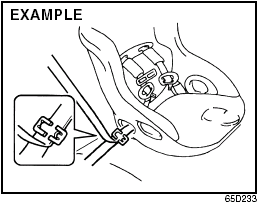
ELR type belt
Install your child restraint system according to the instructions provided by the child restraint system manufacturer. Make sure that the seat belt is securely latched. Try to move the child restraint system in all directions, to make sure it is securely installed.
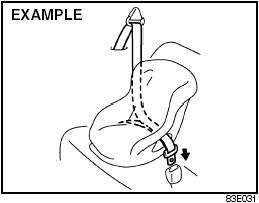
A-ELR type belt
Install your child restraint system according to the instructions provided by the child restraint system manufacturer. If you install the child restraint system in the front seat, be sure to slide the seat to the rearmost position. After making sure that the seat belt is securely latched:
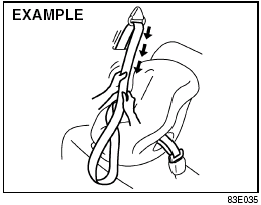
A-ELR type
1) Pull all of the remaining webbing out of the retractor. You will hear a click, which means that the emergency locking retractor (ELR) has converted to function as an automatic locking retractor (ALR).
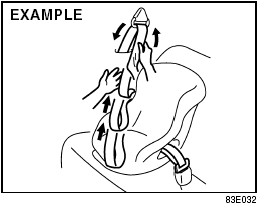
A-ELR type
2) Allow the extra webbing to retract, and pull the webbing toward the retractor to take up any slack. Make sure that the lap portion of the belt is tight around the child restraint system and the shoulder portion of the belt is positioned so that it can not interfere with the child’s head or neck.
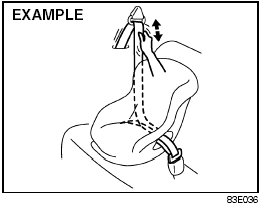 A-ELR type
A-ELR type
3) Make sure that the retractor has converted to the ALR mode by trying to pull webbing out of the retractor. If the retractor is in the ALR mode, the belt will be locked.
 WARNING: If the retractor is
not in the ALR mode, the child restraint system can move or tip over when your vehicle
turns or stops abruptly.
WARNING: If the retractor is
not in the ALR mode, the child restraint system can move or tip over when your vehicle
turns or stops abruptly.
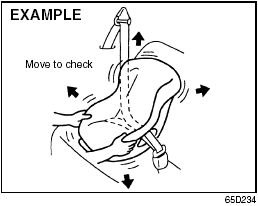
A-ELR type
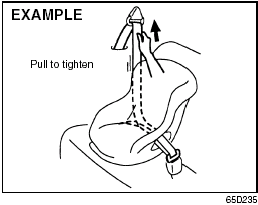
A-ELR type
4) Try moving the child restraint system in all directions, to make sure it is securely installed. If you need to tighten the belt, pull more webbing toward the retractor.
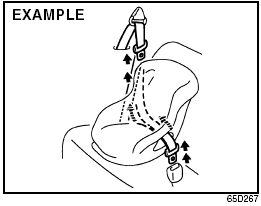
To revert from
ALR to ELR
When you unbuckle the seat belt and allow it to retract to a certain length, the retractor will automatically revert back to the normal ELR mode.
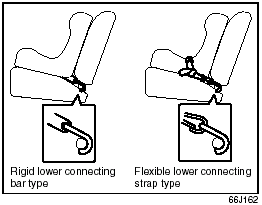
Installation with
the LATCH System
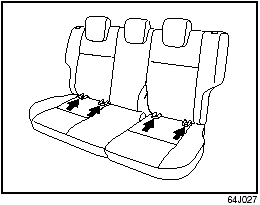
Rear seat
Your vehicle is equipped with lower anchors for securing up to two standard LATCH-type child restraints in the rear seats. (LATCH stands for Lower Anchors and Tethers for Children.) The anchors are located where the rear of the seat cushion meets the bottom of the seatback. Install a LATCH-type child restraint system according to the instructions provided by the child restraint system manufacturer. After installing the child restraint system, try moving it in all directions, especially forward, to make sure the flexible straps or rigid connecting bars are securely latched to the anchors.
NOTE: Although there are three second row seating positions, you cannot install three LATCH type child restraints in the rear seat. You can install one or two LATCH restraint(s). Be sure to install the LATCH type child restraint(s) in the outboard seating positions.
If your LATCH restraint has flexible lower connecting straps, these general instructions apply: 1) If possible, fold the seatback rearward for easier installation. 2) Place the child restraint in the rear seat.
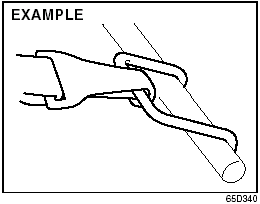
3) Snap the strap hooks to the anchors. Take care not to pinch your fingers.
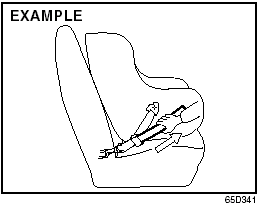
4) Return the seatback to the normal, upright position. Tighten the lower straps as described in the child restraint owner’s manual. Attach the top tether strap, if applicable.
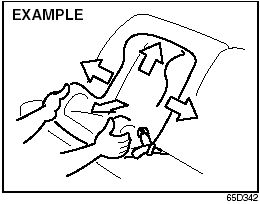
5) Make sure the child restraint is securely fastened by trying to move the child restraint system in all directions, especially forward.
 WARNING: The seatback should
always be securely latched in a fairly upright position when any type of child seat
is installed. An unlatched or reclined seatback will reduce the intended effectiveness
of the child restraint system.
WARNING: The seatback should
always be securely latched in a fairly upright position when any type of child seat
is installed. An unlatched or reclined seatback will reduce the intended effectiveness
of the child restraint system.
If your LATCH restraint has rigid lower connecting bars, these general instructions apply: 1) If possible, fold the seatback rearward for easier installation. 2) Place the child restraint in the rear seat, inserting the connecting bars through the slots in the seat cushion or the slots in the seatback bottom.
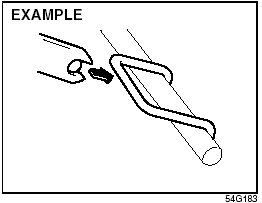
3) Use your hands to carefully align the connecting bar tips with the anchors. Take care not to pinch your fingers.
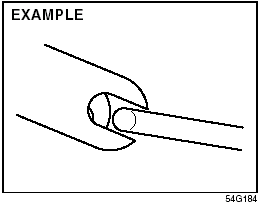
4) Push the child restraint toward the anchors so that the connecting bar tips are partially hooked to the anchors. Use your hands to confirm the position.
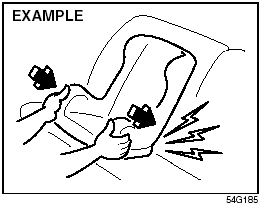
5) Grasp the front of the child restraint and push the child restraint forcefully to latch the connecting bars. Make sure they are securely latched by trying to move the child restraint system in all directions, especially forward. 6) Return the seatback if folded. Attach the top tether strap, if applicable.
 WARNING: The seatback should
always be securely latched in a fairly upright position when any type of child seat
is installed. An unlatched or reclined seatback will reduce the intended effectiveness
of the child restraint system.
WARNING: The seatback should
always be securely latched in a fairly upright position when any type of child seat
is installed. An unlatched or reclined seatback will reduce the intended effectiveness
of the child restraint system.
Installation-Child Restraint with Top Strap
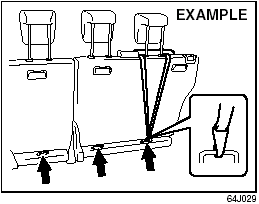
Rear seat
Some child restraint systems require the use of a top strap. Top strap anchor brackets are located on the back of the rear seat as shown in the illustration. Install the child restraint system as follows: 1) Remove the luggage compartment cover. 2) Secure the child restraint on the rear seat using the procedure described above for securing a restraint system that does not require a top strap. 3) Hook the top strap to the anchor bracket and tighten the top strap according to the instructions provided by the child restraint system manufacturer. Be sure to attach the top strap to the corresponding anchor located directly behind the child restraint. Do not attach the top strap to the luggage restraint loops (if equipped).
 WARNING: Do not attach the child
restraint top strap to the luggage restraint loops (if equipped). Incorrectly attached
top strap will reduce the intended effectiveness of the child restraint system.
WARNING: Do not attach the child
restraint top strap to the luggage restraint loops (if equipped). Incorrectly attached
top strap will reduce the intended effectiveness of the child restraint system.
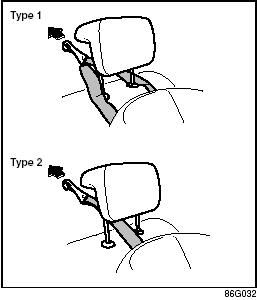
4) When routing the top strap, be sure to pass it between the head restraint and the rear seatback as shown. (Refer to “Head Restraints” section for details on how to raise or lower the head restraint.) 5) Make sure that cargo does not interfere with routing of the top strap.
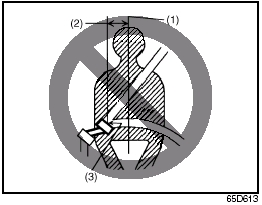
Seat Belt Extender
(1) Center of body (2) Less than 152 mm (6 inches) (3) Open end of extender
buckle
If a seat belt cannot be fastened securely because it is not long enough, see
your authorized SUZUKI dealer for a seat belt extender. Seat belt extenders are
available for each seating position except for the rear center position. After inspecting
the relationship between the seat belt length, the occupant’s body size, and the
seat adjustment (the driver’s seat should always be adjusted as far back as possible
while still maintaining control of the vehicle, and other adjustable seats should
be adjusted as far back as possible), your dealer can select the appropriate seat
belt extender.
• A seat belt extender should only be used for the person, vehicle and seating location
it was provided for.
• When using the extender, ensure that both ends are latched securely. Do not use
the extender if the open end of the extender’s buckle is within 152 mm (6 inches)
of the center of the occupant’s body (See diagram). Use of the extender when the
buckle is too close to the center of the body could increase the risk of abdominal
injury in the event of an accident, and could cause the shoulder belt to be positioned
incorrectly.
• Make sure to use the correct buckle corresponding to your seating position.
• Seat belt extenders are not intended for use by pregnant women, and should only
be used upon approval by their medical advisors.
• Remove and stow the extender when it is not being used.
 WARNING: Failure to follow these
instructions may increase the risk of injury in a crash.
WARNING: Failure to follow these
instructions may increase the risk of injury in a crash.
• Only use an extender for the person, vehicle and seating position it was provided
for.
• Do not use if open end of extender’s buckle is within 152 mm (6 inches) of center
of occupant’s body (See diagram).
• Remove and stow the extender when it is not being used.
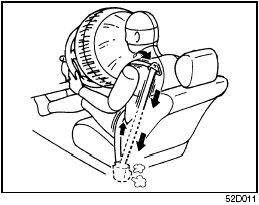
Seat Belt Pretensioner
System (for front seat belt only)
 WARNING: This section of the
owner’s manual describes your SUZUKI’s SEAT BELT PRETENSIONER SYSTEM. Please read
and follow ALL these instructions carefully to minimize your risk of severe injury
or death.
WARNING: This section of the
owner’s manual describes your SUZUKI’s SEAT BELT PRETENSIONER SYSTEM. Please read
and follow ALL these instructions carefully to minimize your risk of severe injury
or death.
Your vehicle is equipped with a seat belt pretensioner system at the front seating positions. You can use the pretensioner seat belts in the same manner as ordinary seat belts. The seat belt pretensioner system works with the SUPPLEMENTAL RESTRAINT SYSTEM (advanced air bags). The crash sensors and the electronic controller of the air bag system also control the seat belt pretensioners. The pretensioners are triggered only when the air bags are triggered and the seat belts are fastened. If the seat belts are not fastened, the respective pretensioner system will not be activated. For precautions and general information including servicing the pretensioner system, refer to the “Supplemental Restraint System (air bags)” section in addition to this “Seat Belt Pretensioner System” section, and follow all those precautions. The pretensioner is located in each front seat belt retractor. The pretensioner tightens the seat belt so the belt fits the occupant’s body more snugly in the event of a frontal crash. The retractors will remain locked after the pretensioners are activated. Upon activation, some noise will occur and some smoke may be released. These conditions are not harmful and do not indicate a fire in the vehicle. The driver and all passengers must be properly restrained by wearing seat belts at all times, whether or not a pretensioner is equipped at their seating position, to minimize the risk of severe injury or death in the event of a crash. Sit fully back in the seat; sit up straight; do not lean forward or sideways. Adjust the belt so the lap portion of the belt is worn low across the pelvis, not across the waist. Please refer to the “Seat Adjustment” section and the instructions and precautions about the seat belts in this “Seat Belts and Child Restraint Systems” section for details on proper seat and seat belt adjustments. Please note that the pretensioners along with the front air bags will activate only in severe frontal collisions. They are not designed to activate in rear impacts, side impacts, rollovers or minor frontal collisions. The pretensioners can be activated only once. If the pretensioners are activated (that is, if the front air bags are activated), have the pretensioner system serviced by an authorized SUZUKI dealer as soon as possible. If the “AIR BAG” light on the instrument cluster does not blink or come on briefly when the ignition switch is turned to the “ON” position, stays on for more than 10 seconds, or comes on while driving, the pretensioner system or the air bag system may not work properly. Have both systems inspected by an authorized SUZUKI dealer as soon as possible. Service on or around the pretensioner system components or wiring must be performed only by an authorized SUZUKI dealer who is specially trained. Improper service could result in unintended activation of pretensioners or could render the pretensioner inoperative. Either of these two conditions may result in personal injury. To prevent damage or unintended activation of the pretensioners, be sure the battery is disconnected and the ignition switch has been in the “LOCK” position for at least 90 seconds before performing any electrical service work on your SUZUKI. Do not touch pretensioner system components or wiring. The wires are wrapped with yellow tape or yellow tubing, and the couplers are yellow. When scrapping your SUZUKI, ask your SUZUKI dealer, body repair shop or scrap yard for assistance.
 Head Restraints
Head Restraints
Head Restraints
Head restraints are designed to help reduce the risk of neck injuries in case
of an accident. Adjust the head restraint to the position which places the center
of the head restra ...
 Supplemental Restraint System (air bags)
Supplemental Restraint System (air bags)
Supplemental Restraint
System (air bags)
WARNING: This section of the
owner’s manual describes the protection provided by your SUZUKI’s SUPPLEMENTAL RESTRAINT
SYSTEM (air bags). Please re ...
See also:
Rain sensor/speed sensitive wiper control
Intermittent operation of the wipers is
controlled initially by either vehicle speed or a
rain sensor located at the upper edge of the
windscreen. Both methods of control will clear
the screens ad ...
Heated front seats
The current seat temperature is shown in the center console display
Press the button once for the
highest heat level – three indicator
lights come on.
Press the button twice for a
lower ...
Current speed in mph (Canadian models only)
This function provides the driver with an instantaneous
conversion of the car's current speed
from km/h to mph. ...
